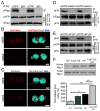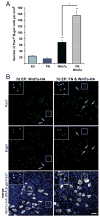Fibronectin regulates Wnt7a signaling and satellite cell expansion
- PMID: 23290138
- PMCID: PMC3539137
- DOI: 10.1016/j.stem.2012.09.015
Fibronectin regulates Wnt7a signaling and satellite cell expansion
Abstract
The influence of the extracellular matrix (ECM) within the stem cell niche remains poorly understood. We found that Syndecan-4 (Sdc4) and Frizzled-7 (Fzd7) form a coreceptor complex in satellite cells and that binding of the ECM glycoprotein Fibronectin (FN) to Sdc4 stimulates the ability of Wnt7a to induce the symmetric expansion of satellite stem cells. Newly activated satellite cells dynamically remodel their niche via transient high-level expression of FN. Knockdown of FN in prospectively isolated satellite cells severely impaired their ability to repopulate the satellite cell niche. Conversely, in vivo overexpression of FN with Wnt7a dramatically stimulated the expansion of satellite stem cells in regenerating muscle. Therefore, activating satellite cells remodel their niche through autologous expression of FN that provides feedback to stimulate Wnt7a signaling through the Fzd7/Sdc4 coreceptor complex. Thus, FN and Wnt7a together regulate the homeostatic levels of satellite stem cells and satellite myogenic cells during regenerative myogenesis.
Copyright © 2013 Elsevier Inc. All rights reserved.
Conflict of interest statement
The authors declare no conflict of interest.
Figures







Comment in
-
Grounding the satellite turns on the signal.Regen Med. 2013 Mar;8(2):119-20. Regen Med. 2013. PMID: 23596648 No abstract available.
References
-
- Adi S, Bin-Abbas B, Wu NY, Rosenthal SM. Early stimulation and late inhibition of extracellular signal-regulated kinase 1/2 phosphorylation by IGF-I: a potential mechanism mediating the switch in IGF-I action on skeletal muscle cell differentiation. Endocrinology. 2002;143:511–516. - PubMed
-
- Allen RE, Boxhorn LK. Regulation of skeletal muscle satellite cell proliferation and differentiation by transforming growth factor-beta, insulin-like growth factor I, and fibroblast growth factor. Journal of cellular physiology. 1989;138:311–315. - PubMed
-
- Ates K, Yang SY, Orrell RW, Sinanan AC, Simons P, Solomon A, Beech S, Goldspink G, Lewis MP. The IGF-I splice variant MGF increases progenitor cells in ALS, dystrophic, and normal muscle. FEBS letters. 2007;581:2727–2732. - PubMed
Publication types
MeSH terms
Substances
Grants and funding
LinkOut - more resources
Full Text Sources
Other Literature Sources
Molecular Biology Databases
Miscellaneous

